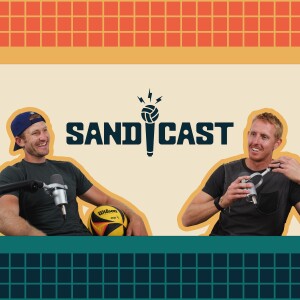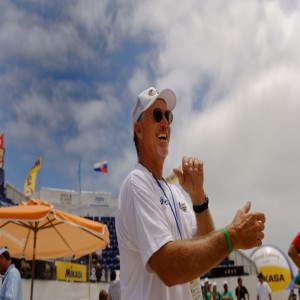
SANDCAST: Beach Volleyball with Tri Bourne and Travis Mewhirter
Sports:Volleyball

On April 10, 1995, Carl Henkel was studying for his law school finals when one of the strangest, most unpredictable and, at that time he would have likely surmised, miraculous phone calls rang in around four in the morning.
“Hey,” said the voice on the other line. “I need you to play this weekend in Spain. Can you make it?”
Henkel nearly dropped the phone. Was that Sinjin Smith on the other side of the line? That Sinjin Smith? Asking him to play?
“How long do I have to think about it?” he asked.
“Well,” Smith recalled telling him on SANDCAST: Beach volleyball with Tri Bourne and Travis Mewhirter. “You’ve got about ten seconds.”
Ten seconds? Here was Henkel, a 25-year-old who had cobbled together a good but not great professional volleyball career. He had played in more than 30 AVPs, finishing in the top 10 twice, and was playing most of his volleyball on the four-man tour. Whittier Law School was, without question, the wiser career move.
So Henkel did what anybody else would do when Sinjin Smith asked you to make a run at the 1996 Atlanta Olympics: “Of course!” Henkel recalled telling Smith, in an interview two winters ago. “Forget these finals. I don’t need these finals. I’ll meet you there!”
Henkel called up his instructors and told them the situation. They worked out a plan to delay his finals. The next day, Henkel was on a plane bound for Marbella, to play a tournament with Smith, the man who had helped co-found both the AVP and FIVB tours and is still considered to be one of the greatest of all-time.
You may, however, be wondering how Smith got here. From the late 1970s through the early 90s, until a bum knee began limiting him, Smith was arguably the best beach volleyball player in the world. Nobody had won more tournaments or more money than him, not even Karch Kiraly or Mike Dodd or Randy Stoklos or Tim Hovland. Nobody had done more for the game.
So how did he end up with Carl Henkel, a guy who hadn’t finished better than ninth on the AVP Tour, who didn’t make the indoor national team, who had spent his most recent days in beach volleyball on the less-heralded four-man tour? Who was studying for a law school final, far away from a beach?
The answer can be boiled down to one name: Ricci Luyties.
A gold medalist on the 1988 indoor team in Seoul, Luyties was a sublime talent, a 6-foot-5 freak of an athlete out of Smith’s hometown, Pacific Palisades. He wasn’t quite the talent that Stoklos, Smith’s longtime partner and the first man to make $1 million in beach volleyball, was, but he had won seven AVPs. They had agreed to make a run for the 1996 Olympics, gunning for the berth that was guaranteed to the top American finishing team on the FIVB. He and Smith would be all but a lock.
And then he pulled out with hardly any warning at all. On the morning of April 10, 1995, he simply left Smith a voicemail: The AVP had pressured him. He wasn’t going to play. He was sorry.
That was the day they were supposed to leave for Spain.
Smith had enough on his mind. His first son, Hagen, had just been born. And now he was supposed to find a partner to go to the Olympics? To give up the next year traveling the world on a tour that didn’t pay well? To drop everything and stay in hotels and planes and abandon whatever other responsibilities they had? And he was supposed to find him in a day?
It was too late in the process to pluck someone from the AVP – which was perhaps the point of the AVP pressuring Luyties so late – so Smith turned to the emergency option: The four-man tour.
“Carl was the first to call me back,” Smith said.
The oddest team in beach volleyball, a legend and a clerk, was born. And they were going to make it.
Smith laughs at all of this now, but still with a shake of the head. There was so much infighting then, just as there is now. It was Smith who, with the help of then-FIVB president Ruben Acosta, helped found the beach side of the FIVB Tour. And it was Smith who helped usher it to the Olympics, despite a heavy, though understandable, pushback from the AVP, a tour and union he also helped found.
“We had an event alongside the ’92 Olympics in Barcelona, to showcase the sport for the IOC,” Smith said. “That’s the event that Randy and I were sanctioned $70,000 by the AVP for going [instead of competing at the AVP event in Seal Beach that weekend]. We happened to win that amount of money. And then the AVP kept us from playing in the biggest events of the season, events that we would win most of the time.
“But from that, the sport became an Olympic sport, so it was all worthwhile in the end for us. They said ‘It’ll never be an Olympic sport, you’re just blowing in the wind.’ So it became an Olympic sport. It was awesome.”
Smith and Henkel would go on to finish fifth at the Atlanta Games, though before they bowed out, they put on perhaps the greatest volleyball match of all-time, a 15-17 quarterfinal loss to Kiraly and Kent Steffes.
“I remember that well,” Smith said.
Some will. Some won’t. But nobody can argue the impact that Smith has had on the sport. The AVP continues to operate as the only domestic professional tour, with prize money that is now eclipsing all but three events on the world tour. The world, which lagged considerably in Smith’s days as a player, has caught up, with teams from Norway, Latvia, Germany, Brazil, Russia, Italy all populating the top-10 rankings.
“It took a little while but players started adjusting to the beach,” Smith said. “We were so good because we had a tour. We had a place to compete, and when you have that tour and you can make money and travel around and you can make a lot competing, you have an advantage over any country that’s not competing.”
Now they’re all competing. They’ve all either caught up or are catching up. And Smith still can’t get enough.
“We couldn’t get enough volleyball, indoor, outdoor, it didn’t matter,” Smith said. “We just wanted to play. It was pretty awesome.”
More Episodes
 2024-10-23
2024-10-23
 1.3k
1.3k
 2024-10-09
2024-10-09
 1.8k
1.8k
 2024-10-02
2024-10-02
 1.6k
1.6k
 2024-09-23
2024-09-23
 1.2k
1.2k
 2024-09-19
2024-09-19
 1.5k
1.5k
 2024-09-02
2024-09-02
 1.6k
1.6k
 2024-08-29
2024-08-29
 1.5k
1.5k
 2024-08-28
2024-08-28
 1.5k
1.5k
 2024-08-19
2024-08-19
 1.6k
1.6k
Create your
podcast in
minutes
- Full-featured podcast site
- Unlimited storage and bandwidth
- Comprehensive podcast stats
- Distribute to Apple Podcasts, Spotify, and more
- Make money with your podcast
It is Free
- Privacy Policy
- Cookie Policy
- Terms of Use
- Consent Preferences
- Copyright © 2015-2024 Podbean.com



